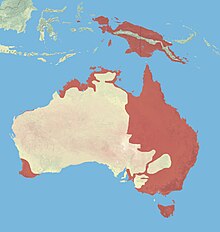| Rakali Temporal range: Holocene
| |
|---|---|

| |
| Scientific classification | |
| Domain: | Eukaryota |
| Kingdom: | Animalia |
| Phylum: | Chordata |
| Class: | Mammalia |
| Order: | Rodentia |
| Family: | Muridae |
| Genus: | Hydromys |
| Species: | H. chrysogaster
|
| Binomial name | |
| Hydromys chrysogaster Geoffroy, 1804
| |

| |
| Distribution of the rakali | |
The rakali (Hydromys chrysogaster), also known as the rabe, the "Australian Otter" or water-rat, is an Australian native rodent first scientifically described in 1804.[2] Adoption of the Ngarrindjeri name rakali is intended to foster a positive public attitude by Environment Australia.[3][4]
One of four described species in the genus Hydromys, it is the only one with a range extending beyond New Guinea. Having adapted to and colonised a unique niche of a semiaquatic and nocturnal lifestyle,[5] this species lives in burrows on the banks of rivers, lakes and estuaries and feeds on aquatic insects, fish, crustaceans, mussels, snails, frogs, bird's eggs and small water birds.
Rakali have a body length of 23–37 cm (9–15 in), weigh 340–1,275 g (12–45 oz), and have a thick tail measuring around 24–35 cm (9–14 in). Females are generally smaller than males but tail lengths are normally the same. They have partially webbed hind legs, waterproof fur, a flattened head, a long blunt nose, many whiskers and small ears and eyes. The body is streamlined with a skull that is large, flat and elongated, with two molars on the upper and lower jaw, similar to the water mouse. They are black to brown in colour with an orange to white belly, and dark tail with a white tip.[5]
Long considered a nuisance animal, rakali were hunted for their soft fur, particularly in the Depression of the 1930s, when a ban was placed on imported pelts such as the American muskrat.[6] With their numbers under threat, a protection order was issued in 1938,[7] however they were still subject to destruction permits from 1938 to 1957 due to their effect on irrigation banks and alleged damage to fishing nets.[8] Additionally from 1957 to 1967 a number of licensed seasons were also held for this reason.[9][10]
- ^ Aplin, K.; Copley, P.; Robinson, T.; Burbidge, A.; Morris, K.; Woinarski, J.; Friend, T.; Ellis, M. & Menkhorst, P. (2008). "Hydromys chrysogaster". IUCN Red List of Threatened Species. 2008. Retrieved 2015-02-06.
- ^ Speldwinde, P.C; Close, P; Weybury, M; Comer, S (2013). "Habitat preference of the Australian water rat (Hydromys chryogaster) in a coastal wetland and stream, Two Peoples Bay, south-west Australia". Australian Mammalogy. 35: 188–194. doi:10.1071/AM12001.
- ^ Cite error: The named reference
:3was invoked but never defined (see the help page). - ^ "Rakali names and origin - Australian Platypus Conservancy". platypus.asn.au. 8 March 2024. Retrieved 27 September 2024.
- ^ a b Atkinson, C. A; Lund, M. A; Morris, K. D (2008). "BiblioRakali: the Australian water rat, Hydromys chrysogaster Geoffroy, 1804 (Muridae: Hydromyinae), a subject-specific bibliography" (PDF). Conservation Science Western Australia. 7 (1): 65–71. Retrieved 2015-10-25.
- ^ "Water-rat". The Australian Museum. Retrieved 10 April 2023.
- ^ Cite error: The named reference
:0was invoked but never defined (see the help page). - ^ Cite error: The named reference
:4was invoked but never defined (see the help page). - ^ Seebeck, J; Menkhorst, P (2000). "Status and conservation of rodents in Australia". Wildlife Research. 27: 357–369. doi:10.1071/wr97055.
- ^ Smart, C; Speldewinde, P.C; Mills, H.R (2011). "Influence of habitat characteristics on the distribution of water-rat (Hydromys chrysogeaster) in the greater Perth region, Western Australia" (PDF). Journal of the Royal Society of Western Australia. 94: 533–539. Retrieved 2015-10-23.
